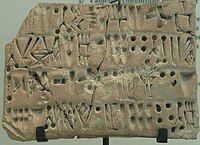
Back Elamities Afrikaans لغة عيلامية Arabic Idioma elamita AST Elam dili Azerbaijani Эламская мова Byelorussian Еламски език Bulgarian Basa Elam BJN Elamiteg Breton Llengua elamita Catalan Elamština Czech
| Elamite | |
|---|---|
 Tablet of Elamite script | |
| Native to | Elam |
| Region | Western Asia, Iran |
| Era | c. 2800–300 BC (Later unwritten forms might have survived until 1000 AD?) |
Early form | language of Proto-Elamite?
|
| Linear Elamite, Elamite cuneiform | |
| Language codes | |
| ISO 639-2 | elx |
| ISO 639-3 | elx |
elx | |
| Glottolog | elam1244 |
Elamite, also known as Hatamtite and formerly as Susian, is an extinct language that was spoken by the ancient Elamites. It was recorded in what is now southwestern Iran from 2600 BC to 330 BC.[1] Elamite works disappear from the archeological record after Alexander the Great entered Iran, but the spoken language might have survived until the 11th century AD.[citation needed] Elamite is generally thought to have no demonstrable relatives and is usually considered a language isolate. The lack of established relatives makes its interpretation difficult.[2]
A sizeable number of Elamite lexemes are known from the Achaemenid royal inscriptions – bilingual or trilingual inscriptions of the Achaemenid Empire, in which Elamite was written using Elamite cuneiform (circa 400 BC), which is fully deciphered. An important dictionary of the Elamite language, the Elamisches Wörterbuch was published in 1987 by W. Hinz and H. Koch.[3][4] The Linear Elamite script however, one of the scripts used to write the Elamite language circa 2000 BC, has remained elusive until recently.[5]
- ^ Stolper 2004, pp. 60–64
- ^ Gragg 2009, p. 316
- ^ Hinz & Koch 1987a
- ^ Hinz & Koch 1987b
- ^ Desset, François (2018). "Linear Elamite writing". The Elamite World: 397. doi:10.4324/9781315658032-21. ISBN 978-1-315-65803-2. in Álvarez-Mon, Basello & Wicks 2018, pp. 405–406
© MMXXIII Rich X Search. We shall prevail. All rights reserved. Rich X Search